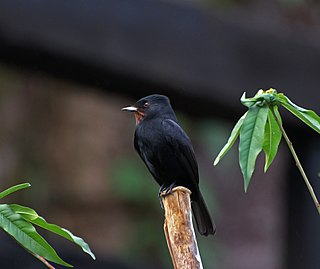
The International Union for Conservation of Nature (IUCN) Red List of Threatened Species, also known as the IUCN Red List or Red Data Book, founded in 1964, is an inventory of the global conservation status and extinction risk of biological species. A series of Regional Red Lists, which assess the risk of extinction to species within a political management unit, are also produced by countries and organizations.

A booby is a seabird in the genus Sula, part of the family Sulidae. Boobies are closely related to the gannets (Morus), which were formerly included in Sula.

The snowcocks or snowfowl are a group of bird species in the genus Tetraogallus of the pheasant family, Phasianidae. They are ground-nesting birds that breed in the mountain ranges of southern Eurasia from the Caucasus to the Himalayas and western China. Some of the species have been introduced into the United States. Snowcocks feed mainly on plant material.

The conservation status of a group of organisms indicates whether the group still exists and how likely the group is to become extinct in the near future. Many factors are taken into account when assessing conservation status: not simply the number of individuals remaining, but the overall increase or decrease in the population over time, breeding success rates, and known threats. Various systems of conservation status are in use at international, multi-country, national and local levels, as well as for consumer use such as sustainable seafood advisory lists and certification. The two international systems are by the International Union for Conservation of Nature (IUCN) and The Convention on International Trade in Endangered Species of Wild Fauna and Flora (CITES).

The fork-tailed woodnymph is a species of hummingbird in the "emeralds", tribe Trochilini of subfamily Trochilinae. It is found in every mainland South American country except Chile and Uruguay.

The Orinoco saltator or Orinocan saltator is a species of saltator in the family Thraupidae. It is found in Venezuela in areas west, north, and upon the Orinoco River region and to the Caribbean coast; also border regions in adjacent northeast Colombia. It can also be found on the eastern shore of Lake Maracaibo. Its natural habitats are subtropical or tropical dry forests, subtropical or tropical moist lowland forests, and subtropical or tropical dry shrubland.

The spectacled tyrant is a species of bird in the tyrant flycatcher family Tyrannidae. It is the only species placed in the genus Hymenops.

The white-winged black tyrant is a species of bird in the family Tyrannidae. It has often included the Sao Francisco black tyrant as a subspecies. It is found in Argentina, Bolivia, Chile, Paraguay, Peru, and Uruguay. Its natural habitats are subtropical or tropical moist montane forests, subtropical or tropical moist shrubland, and heavily degraded former forest.

Knipolegus is a genus of birds, the black tyrants, in the tyrant flycatcher family Tyrannidae.

The blue-billed black tyrant is a species of bird in the family Tyrannidae. It is found in Argentina, Bolivia, Brazil, Paraguay, and Uruguay. Its natural habitats are temperate forests, subtropical or tropical moist montane forests, subtropical or tropical high-altitude shrubland, and heavily degraded former forest.

The São Francisco black tyrant, also known as Caatinga black tyrant or Brazilian black tyrant, is a species of bird in the family Tyrannidae.

Hudson's black tyrant is a species of bird in the family Tyrannidae. It is named after Argentine-British ornithologist William Henry Hudson.

The velvety black tyrant is a species of bird in the family Tyrannidae. It is endemic to Brazil, where its natural habitats are temperate forests, subtropical or tropical moist montane forests, and subtropical or tropical high-altitude shrubland.

The rufous-tailed tyrant is a species of bird in the family Tyrannidae. It is found in Bolivia, Brazil, Colombia, Ecuador, Guyana, Peru, and Venezuela. Its natural habitats are subtropical or tropical moist montane forests, subtropical or tropical high-altitude shrubland, and heavily degraded former forest.

Jelski's black tyrant is a species of bird in the family Tyrannidae. It is found from southern Ecuador to northwestern Argentina. Its natural habitat is subtropical or tropical moist montane forests. This and the plumbeous tyrant are sometimes considered conspecific, in which case, the bird is then usually referred to as the Andean tyrant.

The cinereous tyrant is a species of bird in the family Tyrannidae. The term cinereous describes its colouration. It inhabits the Gran Chaco, where Its natural habitat is subtropical or tropical dry shrubland.

The white-naped xenopsaris, also known as the reed becard and white-naped becard, is a species of suboscine bird in the family Tityridae, the only member of the genus Xenopsaris. It is found in South America, in humid subtropical and tropical savanna climates in most of the countries east of the Andes: Venezuela, Brazil, Bolivia, Paraguay, Uruguay, and Argentina. Living in open woodland and other open forest habitats, it is mostly sedentary, though some populations may be migratory. The species, which is closely related to becards and tityras, was thought to be either a tyrant-flycatcher or cotinga, before it was placed in Tityridae.

The plumbeous tyrant is a species of bird in the family Tyrannidae. It is found in southeastern Peru, western Bolivia and northern Argentina. Its natural habitat is subtropical or tropical moist montane forests. This and the Jelski's black tyrant are sometimes considered conspecific, in which case, the bird is then usually referred to as the Andean tyrant.

The northern white-fringed antwren is an insectivorous bird in the antbird family Thamnophilidae. It is a resident breeder in tropical South America and occurs in northern Colombia, northern Venezuela and on the islands of Tobago and Margarita.






















